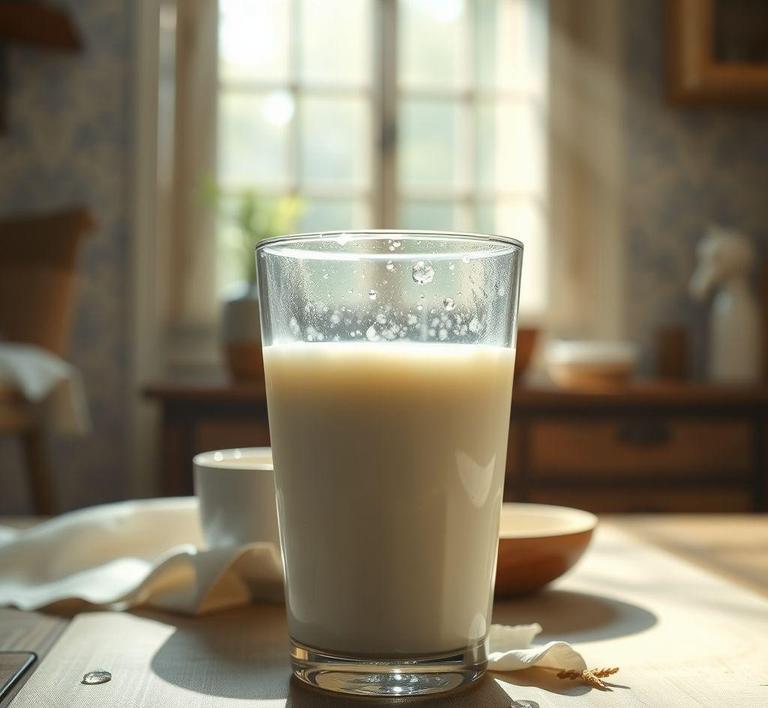If you’ve ever found yourself with more milk than you can drink, or maybe you’re worried about milk going bad before you finish it, you might be wondering: can you refreeze milk? The answer is yes, but there are a few things to keep in mind before you go ahead and toss it back in the freezer. Refreezing milk isn’t quite as simple as just putting it back in the freezer; it can affect the texture, taste, and quality. In this guide, we’ll walk you through how to safely refreeze milk, what to expect after it’s thawed and refrozen, and whether it’s a good idea for your household.
Can You Refreeze Milk?

The simple answer to the question "Can you refreeze milk?" is yes, you can refreeze milk, but with certain considerations and precautions. Freezing milk is a common practice to extend its shelf life, especially when you buy it in bulk or have surplus milk that might go bad before you can use it. However, the process of refreezing milk is a bit more complicated than freezing it the first time. Understanding the science behind freezing and thawing is crucial to maintaining the milk’s safety, flavor, and texture.
Milk, like most liquids, undergoes physical changes when frozen. The water content in milk expands, which can lead to separation of fat and water when thawed. While freezing milk the first time doesn’t usually affect its safety, refreezing it can lead to more noticeable alterations. Refreezing milk is not always advisable, as the quality of the milk might degrade further with each freeze-thaw cycle.
How To Refreeze Milk?
If you find yourself in a situation where refreezing milk is necessary, there are a few essential steps to follow to minimize quality loss and ensure safety:
1. Thawing Properly
- The first step is to thaw the milk slowly in the refrigerator. Rapid thawing, such as using a microwave, can cause uneven temperatures that might encourage bacterial growth, which is something you want to avoid. Slow thawing ensures that the milk stays at a safe temperature.
2. Inspect Before Refreezing
- Once the milk has thawed, check for any signs of spoilage, such as off smells, changes in color, or curdling. If the milk looks or smells strange, it’s best to discard it instead of refreezing it.
3. Stir Or Shake Well
- After thawing, you might notice some separation of fat and liquid. This is perfectly normal. Before deciding to refreeze, you should stir or shake the milk to blend the contents back together. However, keep in mind that while this can restore some of the consistency, it may not fully return the milk to its original texture.
4. Portion Control
- If you’re planning to refreeze milk, consider portioning it into smaller containers. This helps with future thawing, as you’ll only need to thaw what you intend to use. Small portions freeze and thaw more efficiently, reducing the risk of deteriorating quality with repeated freezing.
5. Label And Date
- Always label and date the milk before refreezing it. This ensures that you can track how many times it’s been frozen, and it helps you avoid consuming milk that has been stored for too long, as this can increase the risk of contamination.
6. Use Within A Short Time Frame
- Once the milk is refrozen and thawed again, aim to consume it within a week or two. Refrozen milk doesn’t have the same longevity as freshly frozen milk and can spoil more quickly once thawed the second time.
Quality Impact
The process of freezing and refreezing milk has a noticeable effect on its texture, flavor, and overall quality. Let’s break down the impacts:
Texture
- Milk is composed of water, fat, and proteins, which interact in specific ways to give it its smooth consistency. When frozen, the water in the milk expands, causing the fat and proteins to separate. This results in a grainy or watery texture when thawed. The first time milk is frozen, this change is usually subtle, but with each additional freeze-thaw cycle, the separation becomes more prominent.
- Refreezing milk after it has thawed causes the structure of the milk proteins and fat to break down even further, making the milk more likely to develop an unpleasant texture. When you refreeze milk, you might notice it’s more clumpy, watery, or even slightly lumpy once thawed.
Flavor
- Freezing milk can also affect its flavor. During freezing, the fat molecules in milk can become damaged, which sometimes results in a slight off-taste when the milk is thawed. This is usually more noticeable when the milk has been thawed and refrozen multiple times. As the milk’s fat content undergoes repeated stress, the flavor may turn sour or “off”, and it will lack the fresh, creamy taste of milk that has never been frozen.
Nutritional Value
- Although freezing milk doesn’t significantly impact its nutritional content, there might be some minor loss of certain vitamins, particularly vitamin B12 and vitamin A, which are sensitive to temperature changes. However, these nutrient losses are generally minimal and won’t make a significant difference in the overall nutritional value unless milk is repeatedly frozen and thawed over long periods of time.
Safety Considerations
- One of the most critical concerns when freezing or refreezing milk is food safety. Milk is a perishable item, and improper freezing and thawing can lead to bacterial growth. For example, milk that’s refrozen after being thawed at room temperature or in unsafe conditions can pose a health risk. Always follow proper thawing techniques, such as using the fridge and keeping milk at a consistent temperature, to avoid this issue.
While it is technically possible to refreeze milk, it’s not the most ideal practice if you care about maintaining its original quality. Refreezing milk can impact its texture, flavor, and consistency, making it less enjoyable for drinking or using in recipes. However, if you find yourself needing to refreeze milk, it’s important to follow the proper steps to ensure food safety. Always thaw milk slowly, check it for signs of spoilage, and try to minimize how many times you freeze and thaw it to preserve the best quality possible.
If you do need to freeze milk, a better strategy might be to only freeze what you need in smaller portions so that you can avoid the necessity of refreezing it later. Ultimately, while the milk might still be safe to consume after being refrozen, the taste and texture will be compromised, and this is something to keep in mind when deciding whether to go through the effort. For the best quality, use frozen milk promptly after thawing it, and don’t rely on refreezing it unless absolutely necessary.
Is It Safe To Refreeze Milk?
Milk, a staple in many households, is typically stored in the refrigerator to maintain freshness and prevent spoilage. However, sometimes, you may find yourself needing to freeze milk for later use-whether due to buying in bulk, dealing with an overstock of dairy products, or simply wanting to extend its shelf life. The question arises, "Is it safe to refreeze milk?"
In short: Yes, it is technically safe to refreeze milk, but with some important caveats. Freezing milk can cause the liquid to separate, and refreezing it only exacerbates this issue. This happens because milk contains water, fats, and proteins, which all behave differently when exposed to low temperatures. When milk is frozen, the water content turns to ice, causing the fat and proteins to clump together, resulting in a grainy, less smooth texture when thawed. While this won’t make the milk unsafe to consume, it will affect the taste and texture, especially when used in beverages like coffee or tea.
However, the real concern when refreezing milk lies in the quality and safety aspects. Refreezing milk after it has already been thawed can expose it to temperature fluctuations that promote bacterial growth, especially if the milk has been sitting at room temperature for extended periods. This raises the risk of foodborne illness, so it’s crucial to ensure that the milk has been thawed in the refrigerator and never left out at room temperature for longer than two hours.
Signs That Milk Should Not Be Refrozen
Refreezing milk might seem like a convenient solution to avoid waste, but not all milk is suitable for this process. To avoid compromising your health or the quality of your dairy products, it’s important to know when milk should not be refrozen.
- Signs of Spoilage Before Freezing: If milk has already started to sour or has an off smell before freezing, it should never be refrozen. Spoiled milk, whether frozen or not, harbors harmful bacteria that can lead to food poisoning.
- Milk Left Out Too Long: If milk has been left out of the fridge for more than two hours before being frozen, it is likely to have reached a temperature conducive to bacterial growth. This means refreezing it could put you at risk of consuming harmful pathogens. In this case, it’s best to discard the milk.
- Improper Thawing: If you’ve thawed milk too quickly-say, in a microwave or at room temperature-refreezing it is not advisable. Thawing milk improperly can cause it to separate, curdle, or develop an undesirable texture, and further freezing will only make things worse.
- Milk Shows Visible Signs of Separation or Clumping: If the milk already appears lumpy, separated, or curdled before freezing, it’s better to avoid refreezing. While freezing milk causes some separation naturally, pre-existing issues mean that the quality will be far worse once refrozen.
- Off Color or Unusual Smell: If the milk has an unusual color, such as being yellowish or pinkish, or an unpleasant odor, it should be discarded. This can indicate contamination or that the milk has gone bad, making it unsafe to refreeze.
Common Refreezing Mistakes
Refreezing milk may seem simple enough, but there are several common mistakes people make that can reduce the quality of the milk or, worse, make it unsafe to consume. Avoiding these errors will ensure that you handle your dairy with care.
- Freezing Milk in Large Quantities: Freezing large containers of milk without dividing it into smaller portions is a frequent mistake. When thawing a large jug or carton, the milk may not defrost evenly, leading to a loss of quality. It’s best to freeze milk in smaller portions, such as ice cube trays or smaller containers, to make thawing more manageable.
- Refreezing After It Has Already Thawed at Room Temperature: One of the biggest mistakes is letting milk thaw at room temperature and then refreezing it. This creates a situation where the milk has spent too much time in the temperature danger zone (40°F to 140°F), allowing bacteria to proliferate. Always ensure that milk is thawed in the refrigerator to minimize these risks.
- Freezing Milk in its Original Carton: While it may seem convenient to freeze milk in its original carton, this is not always ideal. Milk expands as it freezes, so the original container may burst or crack. It’s better to transfer the milk to an airtight, freezer-safe container that allows room for expansion.
- Thawing Milk Improperly: Thawing milk too quickly, such as by placing it in warm water or microwaving it, can cause the texture to degrade. This improper thawing leads to clumping, separation, and an undesirable consistency. It’s always best to thaw milk slowly in the fridge to maintain the quality.
- Refreezing Multiple Times: Each cycle of freezing and thawing milk degrades its quality. The more times you refreeze milk, the worse its texture and taste will become. Refreezing milk multiple times also increases the risk of bacterial contamination. Ideally, milk should only be frozen once and consumed within a reasonable time after thawing.
Tips And Tricks
If you’ve decided that refreezing milk is the right solution for your needs, there are a few tips and tricks that can help you make the most of the process:
- Portion Control: Freeze milk in small, single-use portions, either in plastic bags or ice cube trays. This way, you only defrost what you need and avoid the need to refreeze leftover milk. You can always combine the cubes into a larger container once frozen if desired.
- Use Freezer-Safe Containers: Always use containers that are labeled freezer-safe. These are designed to handle the expansion of liquids as they freeze, preventing leaks or cracks. Ensure the containers are air-tight to prevent freezer burn.
- Label Everything: Clearly mark the date of freezing on your containers to keep track of how long the milk has been stored. Frozen milk typically lasts about 3-6 months, but it’s best to use it sooner rather than later for optimal taste and quality.
- Thaw Slowly: When ready to use, always thaw milk in the refrigerator overnight or for 24 hours. Avoid using a microwave or hot water, as this will cause the milk to heat unevenly and result in curdling.
- Consider Alternative Uses: Even if the milk has separated after freezing, it may still be suitable for cooking, baking, or adding to smoothies. In these cases, texture is less important, and the milk can be fully incorporated into the recipe.
- Shake Well After Thawing: Once milk has thawed, it may appear separated. This is normal. Gently shake the container or stir the milk to reintegrate the fat and water, which will improve its texture before use.
Conclusion
Refreezing milk is indeed possible, but it comes with important considerations regarding safety, texture, and overall quality. While the practice can help extend the shelf life of milk and reduce waste, it’s crucial to follow proper freezing, thawing, and storage techniques to avoid compromising both the safety and taste of your dairy. Avoid common mistakes like refreezing milk that has been left out too long or thawed improperly, and always strive for smaller portions, proper labeling, and slow thawing to ensure the best results. With these guidelines in mind, you can safely freeze and refreeze milk without sacrificing too much quality, making sure you can enjoy it without worry for months to come.


